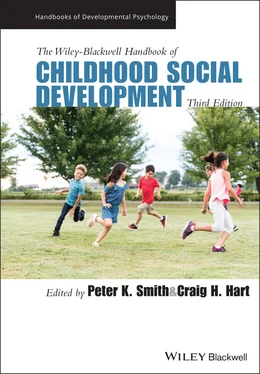107 Lawrence, C., Carlson, E., & Egeland, B. (2006). The impact of foster care on development. Development and Psychopathology, 18(1), 57–76.
108 Lengua. L., & Kovacs, E. A. (2005). Bidirectional associations between temperament and parenting and the prediction of adjustment problems in middle childhood. Journal of Applied Developmental Psychology, 26, 21–38.
109 Letourneau, N. L., Duffett‐Leger, L., Levac, L., Watson, B., & Young‐Morris, C. (2013). Socioeconomic status and child development: A meta‐analysis. Journal of Emotional and Behavioral Disorders. 21(3), 211–224.
110 Lewis, M. (2014). The rise of consciousness and the development of emotional life. Guilford Press.
111 Livingstone, S., & Haddon, L. (2009). Kids online: Opportunities and risks for children. Policy Press.
112 Lord, H., & Mahoney, J. L. (2007). Neighborhood crime and self‐care: Risks for aggression and lower academic performance. Developmental Psychology, 43(6), 1321–1333.
113 MacCallum, R. , & Austin, J. (2000). Applications of structural equation modeling in psychological research. Annual Review of Psychology, 51, 201–226.
114 Maccoby, E. E. (2015). Historical overview of socialization research and theory. In J. E. Grusec & P. D. Hastings (Eds.), Handbook of socialization: Theory and research (pp. 3–32). Guildford Press.
115 Maclean, K. (2003). The impact of institutionalization on child development. Development and Psychopathology, 15, 853–888
116 Magnusson, D., & Stattin, H. (1998). Person‐context interaction theories. In W. Damon & R. M. Lerner (Eds.), Handbook of child psychology: Theoretical models of human development (pp. 685–759). Wiley.
117 Mares, M., Braun, M. T., & Hernandez, P. (2012). Pessimism and anxiety: Effects of tween sitcoms on expectations and feelings about peer relationships in school. Media Psychology, 15, 121–147.
118 Mares, M., & Woodard, E. H. (2001). Prosocial effects on children’s social interactions. In D. G. Singer & J. Singer (Eds.), Handbook of children and the media (pp. 183–203). Sage.
119 Masten, A., & Cicchetti, D. (2010). Developmental cascades. Development and Psychopathology, 22(3), 491–495.
120 Masten, A. S., Roisman, G. I., Long, J. D., Burt, K. B., Obradović, J., Riley, J. R., Boelcke‐Stennes, K., & Tellegen, A. (2005). Developmental cascades: Linking academic achievement and externalizing and internalizing symptoms over 20 years. Developmental Psychology, 41(5), 733–746.
121 Mathiesen, K. S., & Prior, M. (2006). The impact of temperament factors and family functioning on resilience processes from infancy to school age. European Journal of Developmental Psychology, 3, 357–387.
122 Meredith, W., & Tisak, J. (1990). Latent curve analysis. Psychometrika, 55(1), 107–122.
123 McCartney, K., Burchinal, M., Clarke‐Stewart, A., Bub, K. L., Owen, M. T., & Belsky. J. (2010). Testing a series of causal propositions relating time in child care to children’s externalizing behavior. Developmental Psychology, 46, 1–17.
124 Mead, G. H. (1913). The social self. Journal of Philosophy, Psychology, and Scientific Methods, 10, 374–380.
125 Melhuish, E. C. (2001). The quest for quality in early daycare and preschool experience continues. International Journal of Behavioral Development, 25, 1–6.
126 Menesini, E., & Spiel, C. (2012). Cyberbullying: Development, consequences, risk, and protective factors. European Journal of Developmental Psychology, 9(2), 163–167.
127 Miyazaki, M., & Hiraki, K. (2006). Delayed intermodal contingency affects young children's recognition of their current self. Child Development, 77, 736–750.
128 Mize, J., & Pettit, G. S. (1997). Mothers’ social coaching, mother–child relationship style, and children’s peer competence: Is the medium the message? Child Development, 68, 291–311.
129 Morris, D. P., Soroker, E., & Burruss, G. (1954). Follow‐up studies of shy, withdrawn children I: Evaluation of later adjustment. American Journal of Orthopsychiatry, 24, 743–754.
130 Mulligan, G., Douglas, J. W. B., Hammond, W. A., & Tizard, J. (1963). Delinquency and symptoms of maladjustment: The findings of a longitudinal study. Proceedings of the Royal Society of Medicine, 56, 183–186.
131 Nelson, C. A., de Haan, M., & Thomas, K. M. (2006). Neuroscience of cognitive development: The role of experience and the developing brain. Wiley.
132 Nelson, C. A., Zeanah, C. H., & Fox, N. A. (2007). The Effects of early deprivation on brain‐behavioral development: The Bucharest Early Intervention Project. Oxford University Press.
133 Nelson, D. A., Coyne, S. M., Swanson, S. M., Hart, C. H., & Olsen, J. A. (2014). Parenting, relational aggression, and borderline personality features: Associations over time in a Russian longitudinal study. Development and Psychopathology, 26, 773–787.
134 Newton, E. K., Laible, D., Carlo, G., Steele, J. S., & McGinley, M. (2014). Do sensitive parents foster kind children, or vice versa? Bidirectional influences between children’s prosocial behavior and parental sensitivity. Developmental Psychology, 50, 1808–1816.
135 NICHD Early Child Care Research Network (2005). Child Care and child development: Results from the NICHD Study of Early Child Care and Youth Development. Guilford Press.
136 Nolen‐Hoeksema, S., Girgus, J. S., & Seligman, M. E. (1992). Predictors and consequences of childhood depressive symptoms: A 5‐year longitudinal study. Journal of Abnormal Psychology, 101, 405–422.
137 Nucci, L. P., & Gingo, M. (2011). The development of moral reasoning. In U. Goswami (Ed.), The Wiley‐Blackwell handbook of childhood cognitive development (pp. 420–444). Wiley‐Blackwell.
138 Ojanen, T., & Perry, D. G. (2007). Relational schemas and the developing self: Perceptions of mother and of self as joint predictors of early adolescents' self‐esteem. Developmental Psychology, 43(6), 1474–1483.
139 Olweus, D. (1978). Aggression in the schools: Bullies and whipping boys. Washington, DC: Hemisphere.
140 Olweus, D. (1979). Stability of aggressive reaction patterns in males: A review. Psychological Bulletin, 86, 852–875.
141 Olweus, D., & Limber, S. (2010). The Olweus Bullying Prevention Program: Implementation and evaluation over two decades. In S. Jimerson, S. Swearer, & D. Espelage (Eds.), Handbook of bullying in schools: An international perspective (pp. 377–401). Routledge.
142 Pabian, S., & Vandebosch, H. (2016). Developmental trajectories of (cyber)bullying perpetration and social intelligence during early adolescence. Journal of Early Adolescence, 36, 145–170.
143 Parke, R. D., Ornstein, P. A., Rieser, J. J., & Zahn‐Waxler, C. (Eds.). (1994). A century of developmental psychology. American Psychological Association.
144 Parker, J. G., & Seal, J. (1996). Forming, losing, renewing, and replacing friendships: Applying temporal parameters to the assessment of children's friendship experiences. Child Development, 67, 2248–2268.
145 Pascual‐Sagastizabal, E., Azurmendi, A., Braza, F., Vergara, A. I., Cardas, J., & Sánchez‐Martín, J. R. (2014). Parenting styles and hormone levels as predictors of physical and indirect aggression in boys and girls. Aggressive Behavior, 40(5), 465–473.
146 Patrick, M. E., & Schulenberg, J. E. (2014). Prevalence and predictors of adolescent alcohol use and binge drinking in the United States. Alcohol Research: Current Reviews, 35, 193–200.
147 Pea, R., Nass, C., Meheula, L., Rance, M., Kumar, A., Bamford, H., Nass, M., Simha, A., Stillerman, B., Yang, S., & Zhou, M. (2012). Media use, face‐to‐face communication, media multitasking, and social well‐being among 8‐ to 12‐year‐old girls. Developmental Psychology, 48(2), 327–336.
148 Penfield, W. (1961). Activation of the record of human experience. Annals of the Royal College of Surgeons of England, 29, 77–84.
Читать дальше












